In those golden days of faded shades when summer seeps into autumn and the holiday crowds have mostly dispersed, Cornwall's coastline is at its prime for intertidal exploration. The UK has some of the world's largest intertidal zones - transient spaces that fleetingly reveal the ocean’s secrets before swallowing them once more. As the sea ebbs and flows, it creates an ever-changing landscape of sculpted sand, pooling pockets of seawater and living beings, temporarily trapped by craggy and undulating terrain.
Treasures of our shoreline
Amelia Bridges
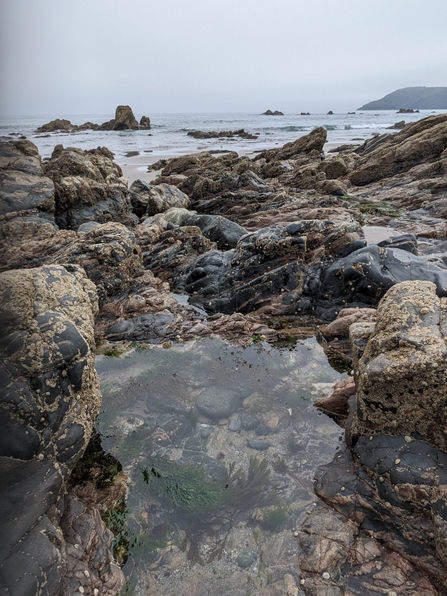
Rock Pools at Kennack Sands, image by Lauren Holford
Powerful waves and currents add to the mix, with the upheaval of stone and wrenching of seaweeds. It's a dynamic environment of displacement and rearrangement, constantly in flux with no two tides the same. There’s a magic in never knowing what you might find there. Treasures are cast ashore or washed into hidden crevices before later being snatched away again.
Around the autumn equinox in late September (and its spring counterpart), the gravitational pull of the moon and sun align and are at their strongest, creating the highest high tides and lowest low tides of the year. These great or super tides make for a particularly rewarding time to get out and survey our coast as part of our Shoresearch week, whether you’re walking your local beach, out with the kids or simply exploring the different corners of Cornwall.
The race is on for intertidal inhabitants
Frequently unnoticed and unsung compared to some of our more charismatic marine megafauna, the inhabitants of the intertidal zone are impressively adaptable and resilient, withstanding huge changes in moisture, oxygen, salinity, light and temperature. Shrimps and prawns may dart around along with juvenile fish such as gobies, but the sedentary speed at which many intertidal creatures live can make them seem as permanent a fixture as the rocks they encrust.
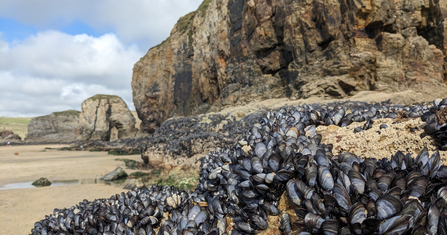
Mussel encrusted rocks exposed at low tide, image by Lauren Holford
Once covered by the tide, however, slow-motion races and battles commence as several common inhabitants hurry to feed during their window of submersion. Easily overlooked, the pimpled forms of limpets loosen their armoured hold to seek out and vacuum up algae with their tongue - incredibly the strongest biological structure known on Earth! They retrace their mucus trail back to the same ‘home’ spot with each tide, giving the illusion of never having moved.
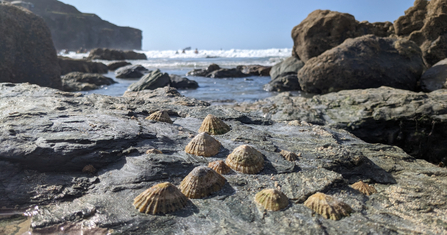
The pimpled forms of limpets, image by Lauren Holford
Colourful or patterned sea snails such as periwinkles or topshells may be more coveted by beachcombers, but examine a limpet’s empty shield, or perhaps the hinged shell of a mussel that lies open like a butterfly in the sand, and you may just see the perfectly drilled hole that is evidence of a fearsome predator.
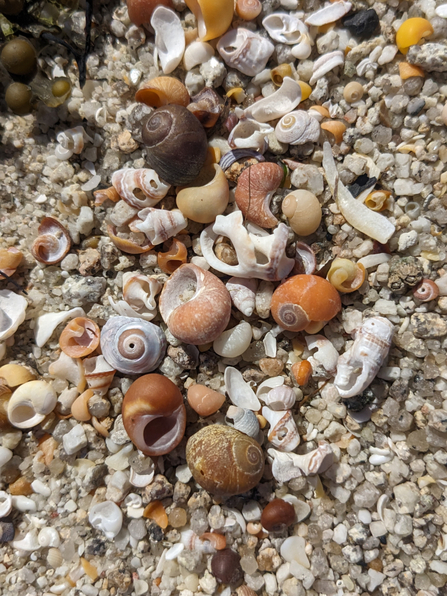
The colourful shells of flat periwinkles washed up along the shore. Image by Lauren Holford
Snail-like dog whelks seem delicately pretty with their decorative, swirling shell, but these carnivores stalk the rocks, boring pinpoint holes into limpets, mussels and barnacles to dissolve and suck out their insides. Despite appearances, mussels aren’t defenceless to these attacks and use the sticky threads that anchor them in rough seas to immobilise and starve the predatory dog whelks - an evolutionary arms race taking place at a snail’s pace!
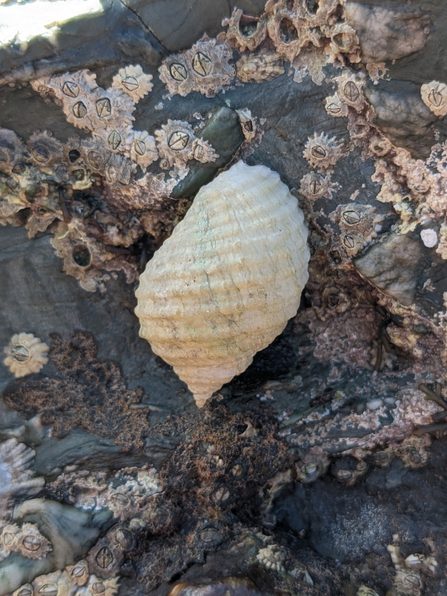
The decorative swirling shell of a dog whelk. Image by Lauren Holford
A deep-dive on decorative predators
Other deceivingly decorative predators found in our rockpools are sea anemones, otherworldly creatures that lie somewhere between coral and jellyfish. Typically glistening, gelatinous blobs when exposed, they unfurl stinging tentacles that gracefully dance through the water paralysing and ensnaring their prey. Look for the mottled skin of the strawberry anenome, the string of blue spots that adorn the base of the beadlet anemone or the Medusa-like snakelocks anemone of flowing green worms that remain extended and glossy even when the tide retreats.
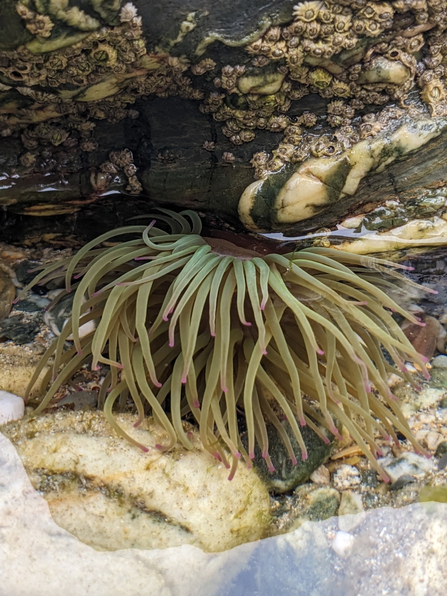
Snakelocks sea anemone, image by Lauren Holford
More widely recognised, but perhaps not for their predatory nature, are starfish. There are actually a variety to be found patrolling our intertidal spaces, ranging from the podgy-yet-cute, fingernail-sized cushion starfish to delicate feather or brittle stars and more hefty specimens like the spiny starfish and sun stars.
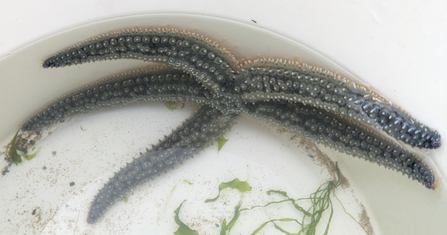
The hefty bulk of a spiny starfish, image by Lauren Holford
Starfish use thousands of sucker-like feet on their underside to slowly seek out and feast on a variety of molluscs and crustaceans. Like dog whelks, they are able to dissolve prey, but incredibly starfish do this by turning their stomachs inside out through their mouth to partly digest their victim before absorbing the soupy remains. They are also well-adapted to avoid predation themselves by self-severing legs when attacked, which they can later regrow and even regenerate into an identical clone if some of their central mass stays intact.
Bringing common crustaceans out of their shell
The frequently pocked surfaces of Cornwall’s tidal rocks may go unnoticed until they hurt human feet, but these surfaces are in fact a mass of living crustaceans known as acorn barnacles. When covered, legs protrude from these creatures into the water to feed, and during the breeding season steadfast males extend the world’s largest penis in proportion to their size!

The pocked surface of acorn barnacles. Image by Lauren Holford
Less frequently found, goose barnacles were once scrapped off Cornish ships and sold as a culinary delight. Named for their supposed visual similarity to the head of a barnacle goose, until the conundrum of migratory birds was discovered, these two very distinct species were once believed to be different stages of the same creature's life cycle. They are now mostly found attached to flotsam that arrives on our shore.
More familiar among our crustaceans are crabs, which are best spotted buried beneath stones or under ledges in our rockpools. Shore crabs, usually in a beautiful mottled green, are most common, while edible crabs can be identified by their chunky black-tipped claws and a body with crimped edges that resemble a pasty.
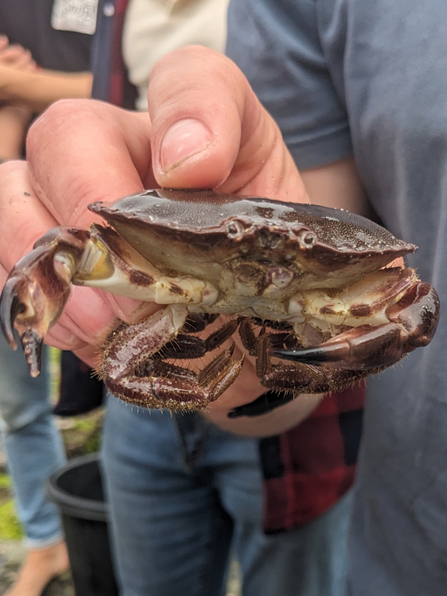
An edible crab. Image by Lauren Holford
Other species include the velvet swimming or ‘devil’ crab, the red eyes of which warn of its aggression (fingers beware!) and the fragile little porcelain crab (reminding us to replace any lifted stones very carefully). Crabs with a larger, rounded ‘tail’ on the underside are females and this feature enables them to carry thousands of orange eggs - a state referred to as 'berried'.
Stars of the strandline
Sometimes, the pillaged or moulted carcasses of crabs wash up along our beaches alongside the calcified, torpedo-shaped remains of one of the ocean’s most remarkable inhabitants: cuttlefish. Often elusive in the water, they are astonishingly intriguing in the way they are able to change colour, shape and texture to become perfectly camouflaged in their environment. Known as cuttle bones, in life these lightweight structures form the inner support and flotation for these shape-shifters’ soft bodies.
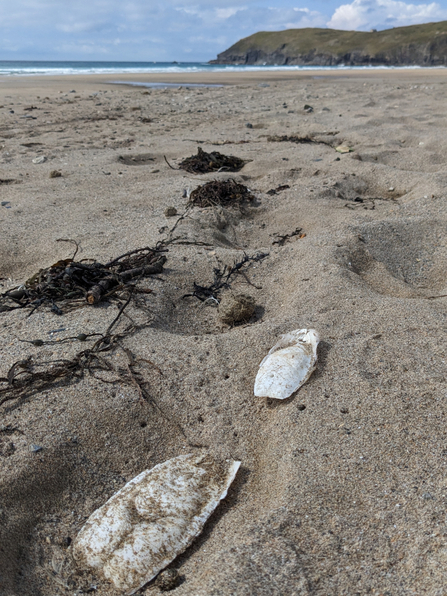
The calcified, torpedo-shaped remains of cuttlefish. Image by Lauren Holford
Nearby, ribbons of seaweeds such as kelp, bladderwrack or thongweed, which mesmerise as they rhythmically sway underwater, may lie limp and lifeless on land. However, they are the vestiges of ethereal underwater forests that provide food, shelter and protection for thousands of marine creatures and, entwined in their fronds, can be found clues to the wider marine ecosystem just off our shores.
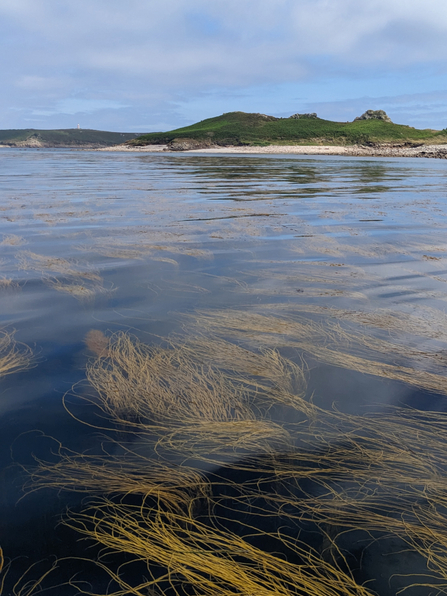
An underwater forest of thongweed. Image by Lauren Holford
Several species of shark and ray lay their young in enclosed egg cases with tendrils that latch onto seaweeds and provide their growing embryos with camouflaged protection. Resembling a leathery pouch, they are evocatively known as mermaid purses, and although they mostly wash up already emptied of their precious cargo, hold them to the light and you can occasionally still see the embryos inside the translucent case. If you do stumble upon one of these population indicators you can identify and record your find as part of the Shark Trust’s citizen science project, The Great Eggcase Hunt.

A spotted ray’s egg case. Image by Lauren Holford
Stormy conditions which litter the strandline with mermaid purses can also blow blooms of thousands of jellyfish ashore in mass strandings, particularly in summer when our waters are at their warmest. From the transparent moon variety to the compass with its radial stripes or the gigantic barrel jellyfish, these are at the mercy of prevailing winds and currents and are a critical indicator species of our warming oceans.
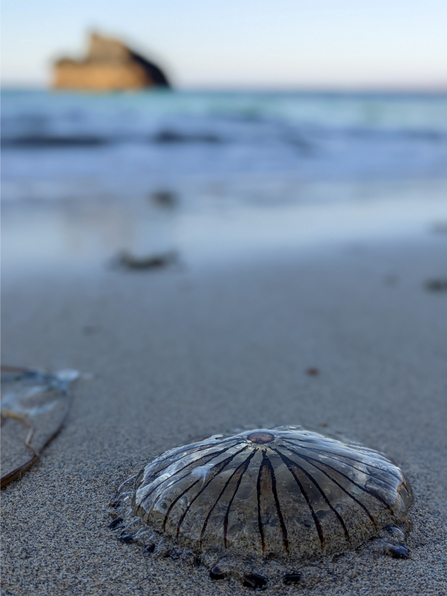
A compass jellyfish. Image by Lauren Holford
Other organisms, nicknamed “by-the-wind-sailors”, are vulnerable to the same fate. Easily mistaken for tiny jellyfish or even a transparent bit of plastic, they are marked with a fingerprint-like impression which when complete is trimmed in blue. Amazingly, these are actually a whole colony of tiny individual animals that sail the seas feeding on prey which they trap in stinging tentacles.
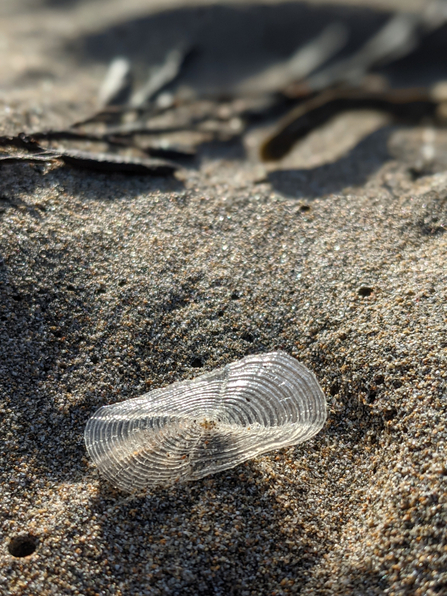
The colony known as a by-the-wind sailor. Image by Lauren Holford
Protect what you love and make a difference
In the ever-evolving realm created by our tides, global travellers, from coconut husks to exotic plant seeds, may reach our shores. Sadly, there are now also ample signs of modern life, including plastics that can be ingested by our marine life, or synthetic threads of fishing line that can all too easily fatally ensnare them. Sometimes, this litter has been in the water so long that piggyback species such as barnacles have adapted to it as part of the environment.
Beach cleans are a small act that defies the paralysis we may feel in the face of the current climate crisis. We are all able to feel the satisfaction of ‘just doing something’ whilst in the mindful act of focusing attention on identifying the ‘odd ones out’. The Your Shore Network regularly hosts beach cleans as social events and, in late September, the Marine Conservation Society run their annual Great British Beach Clean events countrywide, making it possible for greater numbers of people to get involved.
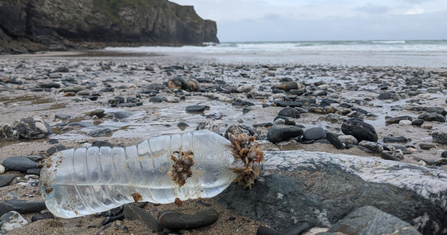
A barnacle-encrusted plastic bottle. Image by Lauren Holford
Stranded animals such as seals or dolphins, whether alive, injured or dead can be reported to the Marine Strandings Network’s growing database. Last year, many gannet carcasses were washed up following the avian influenza that ravaged colonies further North, and periodically, scores of dead fish are spat on to our foreshores, perhaps suggesting instances of chemical waste or sewage discharge. Whether exciting, worrying or simply absent, findings recorded through citizen science projects enhance monitoring and understanding and can serve as evidence to inform public policy.
The Wildlife Trust’s Shoresearch project is an on-going survey that specifically records intertidal data around the UK with an app that can be downloaded to submit findings. Each autumn, Cornwall’s marine conservation groups in Polzeath, St Agnes, Helford, Fowey and Looe celebrate by hosting a week of surveys to engage and train volunteers, running this year from 29th September - 3rd October 2023. It’s the ideal opportunity for curious enthusiasts to gain knowledge, skills and confidence while meeting like-minded, amateur naturalists looking to make a difference.
Like the waves that lap the shore, the more you comb the strandline or peer into rockpools, the more you are instinctively drawn to them. They hold the promise of discovering clues of another world across the oceans or of the wonders that are living beneath the horizon. In these magical, fluid spaces, lies a barometer of our ocean’s health without even having to dip a toe in its water, and a deeper connection with the natural world of which we are all a part.
Read more of Lauren's work on her website or on Instagram @itslollyholly.
